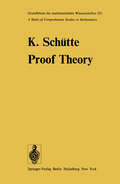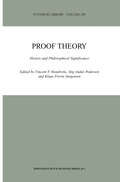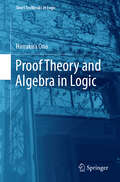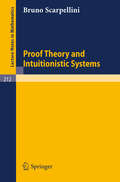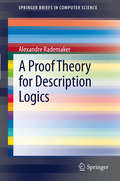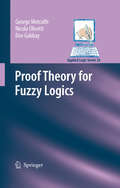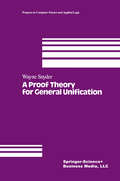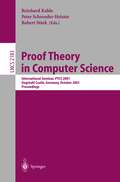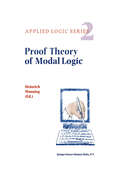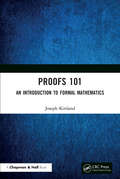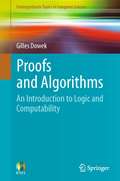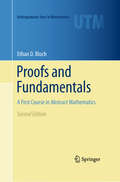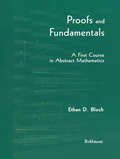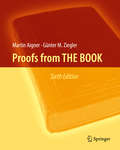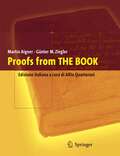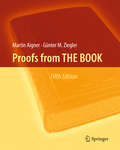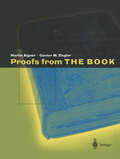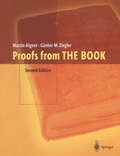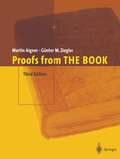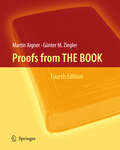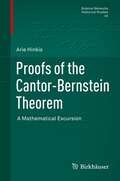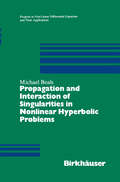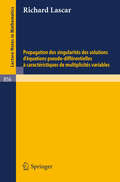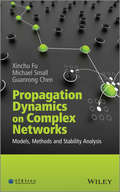- Table View
- List View
Proof Theory: History and Philosophical Significance (Synthese Library #292)
by Vincent F. Hendricks, Stig Andur Pedersen and Klaus Frovin JørgensenhiS volume in the Synthese Library Series is the result of a conference T held at the University of Roskilde, Denmark, October 31st-November 1st, 1997. The aim was to provide a forum within which philosophers, math ematicians, logicians and historians of mathematics could exchange ideas pertaining to the historical and philosophical development of proof theory. Hence the conference was called Proof Theory: History and Philosophical Significance. To quote from the conference abstract: Proof theory was developed as part of Hilberts Programme. According to Hilberts Programme one could provide mathematics with a firm and se cure foundation by formalizing all of mathematics and subsequently prove consistency of these formal systems by finitistic means. Hence proof theory was developed as a formal tool through which this goal should be fulfilled. It is well known that Hilbert's Programme in its original form was unfeasible mainly due to Gtldel's incompleteness theorems. Additionally it proved impossible to formalize all of mathematics and impossible to even prove the consistency of relatively simple formalized fragments of mathematics by finitistic methods. In spite of these problems, Gentzen showed that by extending Hilbert's proof theory it would be possible to prove the consistency of interesting formal systems, perhaps not by finitis tic methods but still by methods of minimal strength. This generalization of Hilbert's original programme has fueled modern proof theory which is a rich part of mathematical logic with many significant implications for the philosophy of mathematics.
Proof Theory and Algebra in Logic (Short Textbooks in Logic)
by Hiroakira OnoThis book offers a concise introduction to both proof-theory and algebraic methods, the core of the syntactic and semantic study of logic respectively. The importance of combining these two has been increasingly recognized in recent years. It highlights the contrasts between the deep, concrete results using the former and the general, abstract ones using the latter. Covering modal logics, many-valued logics, superintuitionistic and substructural logics, together with their algebraic semantics, the book also provides an introduction to nonclassical logic for undergraduate or graduate level courses.The book is divided into two parts: Proof Theory in Part I and Algebra in Logic in Part II. Part I presents sequent systems and discusses cut elimination and its applications in detail. It also provides simplified proof of cut elimination, making the topic more accessible. The last chapter of Part I is devoted to clarification of the classes of logics that are discussed in the second part. Part II focuses on algebraic semantics for these logics. At the same time, it is a gentle introduction to the basics of algebraic logic and universal algebra with many examples of their applications in logic. Part II can be read independently of Part I, with only minimum knowledge required, and as such is suitable as a textbook for short introductory courses on algebra in logic.
A Proof Theory for Description Logics (SpringerBriefs in Computer Science)
by Alexandre RademakerDescription Logics (DLs) is a family of formalisms used to represent knowledge of a domain. They are equipped with a formal logic-based semantics. Knowledge representation systems based on description logics provide various inference capabilities that deduce implicit knowledge from the explicitly represented knowledge.A Proof Theory for Description Logics introduces Sequent Calculi and Natural Deduction for some DLs (ALC, ALCQ). Cut-elimination and Normalization are proved for the calculi. The author argues that such systems can improve the extraction of computational content from DLs proofs for explanation purposes.
Proof Theory for Fuzzy Logics (Applied Logic Series #36)
by George Metcalfe Nicola Olivetti Dov M. GabbayFuzzy logics are many-valued logics that are well suited to reasoning in the context of vagueness. They provide the basis for the wider field of Fuzzy Logic, encompassing diverse areas such as fuzzy control, fuzzy databases, and fuzzy mathematics. This book provides an accessible and up-to-date introduction to this fast-growing and increasingly popular area. It focuses in particular on the development and applications of "proof-theoretic" presentations of fuzzy logics; the result of more than ten years of intensive work by researchers in the area, including the authors. In addition to providing alternative elegant presentations of fuzzy logics, proof-theoretic methods are useful for addressing theoretical problems (including key standard completeness results) and developing efficient deduction and decision algorithms. Proof-theoretic presentations also place fuzzy logics in the broader landscape of non-classical logics, revealing deep relations with other logics studied in Computer Science, Mathematics, and Philosophy. The book builds methodically from the semantic origins of fuzzy logics to proof-theoretic presentations such as Hilbert and Gentzen systems, introducing both theoretical and practical applications of these presentations.
A Proof Theory for General Unification (Progress in Computer Science and Applied Logic #11)
by W. SnyderIn this monograph we study two generalizations of standard unification, E-unification and higher-order unification, using an abstract approach orig inated by Herbrand and developed in the case of standard first-order unifi cation by Martelli and Montanari. The formalism presents the unification computation as a set of non-deterministic transformation rules for con verting a set of equations to be unified into an explicit representation of a unifier (if such exists). This provides an abstract and mathematically elegant means of analysing the properties of unification in various settings by providing a clean separation of the logical issues from the specification of procedural information, and amounts to a set of 'inference rules' for unification, hence the title of this book. We derive the set of transformations for general E-unification and higher order unification from an analysis of the sense in which terms are 'the same' after application of a unifying substitution. In both cases, this results in a simple extension of the set of basic transformations given by Herbrand Martelli-Montanari for standard unification, and shows clearly the basic relationships of the fundamental operations necessary in each case, and thus the underlying structure of the most important classes of term unifi cation problems.
Proof Theory in Computer Science: International Seminar, PTCS 2001 Dagstuhl Castle, Germany, October 7-12, 2001. Proceedings (Lecture Notes in Computer Science #2183)
by Reinhard Kahle Peter Schroeder-Heister Robert StärkProof theory has long been established as a basic discipline of mathematical logic. It has recently become increasingly relevant to computer science. The - ductive apparatus provided by proof theory has proved useful for metatheoretical purposes as well as for practical applications. Thus it seemed to us most natural to bring researchers together to assess both the role proof theory already plays in computer science and the role it might play in the future. The form of a Dagstuhl seminar is most suitable for purposes like this, as Schloß Dagstuhl provides a very convenient and stimulating environment to - scuss new ideas and developments. To accompany the conference with a proc- dings volume appeared to us equally appropriate. Such a volume not only ?xes basic results of the subject and makes them available to a broader audience, but also signals to the scienti?c community that Proof Theory in Computer Science (PTCS) is a major research branch within the wider ?eld of logic in computer science.
Proof Theory of Modal Logic (Applied Logic Series #2)
by Heinrich WansingProof Theory of Modal Logic is devoted to a thorough study of proof systems for modal logics, that is, logics of necessity, possibility, knowledge, belief, time, computations etc. It contains many new technical results and presentations of novel proof procedures. The volume is of immense importance for the interdisciplinary fields of logic, knowledge representation, and automated deduction.
Proofs 101: An Introduction to Formal Mathematics
by Joseph KirtlandProofs 101: An Introduction to Formal Mathematics serves as an introduction to proofs for mathematics majors who have completed the calculus sequence (at least Calculus I and II) and a first course in linear algebra. The book prepares students for the proofs they will need to analyze and write the axiomatic nature of mathematics and the rigors of upper-level mathematics courses. Basic number theory, relations, functions, cardinality, and set theory will provide the material for the proofs and lay the foundation for a deeper understanding of mathematics, which students will need to carry with them throughout their future studies. Features Designed to be teachable across a single semester Suitable as an undergraduate textbook for Introduction to Proofs or Transition to Advanced Mathematics courses Offers a balanced variety of easy, moderate, and difficult exercises
Proofs 101: An Introduction to Formal Mathematics
by Joseph KirtlandProofs 101: An Introduction to Formal Mathematics serves as an introduction to proofs for mathematics majors who have completed the calculus sequence (at least Calculus I and II) and a first course in linear algebra. The book prepares students for the proofs they will need to analyze and write the axiomatic nature of mathematics and the rigors of upper-level mathematics courses. Basic number theory, relations, functions, cardinality, and set theory will provide the material for the proofs and lay the foundation for a deeper understanding of mathematics, which students will need to carry with them throughout their future studies. Features Designed to be teachable across a single semester Suitable as an undergraduate textbook for Introduction to Proofs or Transition to Advanced Mathematics courses Offers a balanced variety of easy, moderate, and difficult exercises
Proofs and Algorithms: An Introduction to Logic and Computability (Undergraduate Topics in Computer Science)
by Gilles DowekLogic is a branch of philosophy, mathematics and computer science. It studies the required methods to determine whether a statement is true, such as reasoning and computation.Proofs and Algorithms: Introduction to Logic and Computability is an introduction to the fundamental concepts of contemporary logic - those of a proof, a computable function, a model and a set. It presents a series of results, both positive and negative, - Church's undecidability theorem, Gödel’s incompleteness theorem, the theorem asserting the semi-decidability of provability - that have profoundly changed our vision of reasoning, computation, and finally truth itself.Designed for undergraduate students, this book presents all that philosophers, mathematicians and computer scientists should know about logic.
Proofs and Fundamentals: A First Course in Abstract Mathematics (Undergraduate Texts in Mathematics)
by Ethan D. Bloch“Proofs and Fundamentals: A First Course in Abstract Mathematics” 2nd edition is designed as a "transition" course to introduce undergraduates to the writing of rigorous mathematical proofs, and to such fundamental mathematical ideas as sets, functions, relations, and cardinality. The text serves as a bridge between computational courses such as calculus, and more theoretical, proofs-oriented courses such as linear algebra, abstract algebra and real analysis. This 3-part work carefully balances Proofs, Fundamentals, and Extras. Part 1 presents logic and basic proof techniques; Part 2 thoroughly covers fundamental material such as sets, functions and relations; and Part 3 introduces a variety of extra topics such as groups, combinatorics and sequences. A gentle, friendly style is used, in which motivation and informal discussion play a key role, and yet high standards in rigor and in writing are never compromised. New to the second edition: 1) A new section about the foundations of set theory has been added at the end of the chapter about sets. This section includes a very informal discussion of the Zermelo– Fraenkel Axioms for set theory. We do not make use of these axioms subsequently in the text, but it is valuable for any mathematician to be aware that an axiomatic basis for set theory exists. Also included in this new section is a slightly expanded discussion of the Axiom of Choice, and new discussion of Zorn's Lemma, which is used later in the text. 2) The chapter about the cardinality of sets has been rearranged and expanded. There is a new section at the start of the chapter that summarizes various properties of the set of natural numbers; these properties play important roles subsequently in the chapter. The sections on induction and recursion have been slightly expanded, and have been relocated to an earlier place in the chapter (following the new section), both because they are more concrete than the material found in the other sections of the chapter, and because ideas from the sections on induction and recursion are used in the other sections. Next comes the section on the cardinality of sets (which was originally the first section of the chapter); this section gained proofs of the Schroeder–Bernstein theorem and the Trichotomy Law for Sets, and lost most of the material about finite and countable sets, which has now been moved to a new section devoted to those two types of sets. The chapter concludes with the section on the cardinality of the number systems. 3) The chapter on the construction of the natural numbers, integers and rational numbers from the Peano Postulates was removed entirely. That material was originally included to provide the needed background about the number systems, particularly for the discussion of the cardinality of sets, but it was always somewhat out of place given the level and scope of this text. The background material about the natural numbers needed for the cardinality of sets has now been summarized in a new section at the start of that chapter, making the chapter both self-contained and more accessible than it previously was. 4) The section on families of sets has been thoroughly revised, with the focus being on families of sets in general, not necessarily thought of as indexed. 5) A new section about the convergence of sequences has been added to the chapter on selected topics. This new section, which treats a topic from real analysis, adds some diversity to the chapter, which had hitherto contained selected topics of only an algebraic or combinatorial nature. 6) A new section called ``You Are the Professor'' has been added to the end of the last chapter. This new section, which includes a number of attempted proofs taken from actual homework exercises submitted by students, offers the reader the opportunity to solidify her facility for writing proofs by critiquing these submissions as if she were the instructor for the course. 7) All known errors have been corrected. 8) Many minor adjustments of wording have been made throughout the text, with the hope of i
Proofs and Fundamentals: A First Course in Abstract Mathematics
by Ethan D. BlochThe aim of this book is to help students write mathematics better. Throughout it are large exercise sets well-integrated with the text and varying appropriately from easy to hard. Basic issues are treated, and attention is given to small issues like not placing a mathematical symbol directly after a punctuation mark. And it provides many examples of what students should think and what they should write and how these two are often not the same.
Proofs from THE BOOK
by Martin Aigner Karl H. Hofmann Günter M. ZieglerThis revised and enlarged sixth edition of Proofs from THE BOOK features an entirely new chapter on Van der Waerden’s permanent conjecture, as well as additional, highly original and delightful proofs in other chapters.From the citation on the occasion of the 2018 "Steele Prize for Mathematical Exposition" “… It is almost impossible to write a mathematics book that can be read and enjoyed by people of all levels and backgrounds, yet Aigner and Ziegler accomplish this feat of exposition with virtuoso style. […] This book does an invaluable service to mathematics, by illustrating for non-mathematicians what it is that mathematicians mean when they speak about beauty.”From the Reviews"... Inside PFTB (Proofs from The Book) is indeed a glimpse of mathematical heaven, where clever insights and beautiful ideas combine in astonishing and glorious ways. There is vast wealth within its pages, one gem after another. ... Aigner and Ziegler... write: "... all we offer is the examples that we have selected, hoping that our readers will share our enthusiasm about brilliant ideas, clever insights and wonderful observations." I do. ... "Notices of the AMS, August 1999"... This book is a pleasure to hold and to look at: ample margins, nice photos, instructive pictures and beautiful drawings ... It is a pleasure to read as well: the style is clear and entertaining, the level is close to elementary, the necessary background is given separately and the proofs are brilliant. ..."LMS Newsletter, January 1999"Martin Aigner and Günter Ziegler succeeded admirably in putting together a broad collection of theorems and their proofs that would undoubtedly be in the Book of Erdös. The theorems are so fundamental, their proofs so elegant and the remaining open questions so intriguing that every mathematician, regardless of speciality, can benefit from reading this book. ... " SIGACT News, December 2011
Proofs from the Book: Edizione italiana a cura di Alfio Quarteroni
by Martin Aigner Günter ZieglerPaul Erdos amava parlare del Libro in cui Dio conserva le dimostrazioni perfette per i teoremi matematici, seguendo il detto di G. H. Hardy secondo il quale non vi è posto perenne per la matematica brutta. Erdos disse anche che non è necessario credere in Dio, tuttavia in quanto matematici si deve credere nel Libro. Alcuni anni fa gli autori gli suggerirono di scrivere una prima (e assai modesta) approssimazione del Libro. Egli fu entusiasta e, come gli era peculiare, si mise immediatamente al lavoro, riempiendo pagine su pagine con i suoi suggerimenti. Essendo sfortunatamente morto nell'estate del 1996, Paul non compare come co-autore. Tuttavia questo libro è dedicato alla sua memoria.
Proofs from THE BOOK
by Martin Aigner Günter M. ZieglerThis revised and enlarged fifth edition features four new chapters, which contain highly original and delightful proofs for classics such as the spectral theorem from linear algebra, some more recent jewels like the non-existence of the Borromean rings and other surprises.From the Reviews"... Inside PFTB (Proofs from The Book) is indeed a glimpse of mathematical heaven, where clever insights and beautiful ideas combine in astonishing and glorious ways. There is vast wealth within its pages, one gem after another. ... Aigner and Ziegler... write: "... all we offer is the examples that we have selected, hoping that our readers will share our enthusiasm about brilliant ideas, clever insights and wonderful observations." I do. ... "Notices of the AMS, August 1999"... This book is a pleasure to hold and to look at: ample margins, nice photos, instructive pictures and beautiful drawings ... It is a pleasure to read as well: the style is clear and entertaining, the level is close to elementary, the necessary background is given separately and the proofs are brilliant. ..." LMS Newsletter, January 1999"Martin Aigner and Günter Ziegler succeeded admirably in putting together a broad collection of theorems and their proofs that would undoubtedly be in the Book of Erdös. The theorems are so fundamental, their proofs so elegant and the remaining open questions so intriguing that every mathematician, regardless of speciality, can benefit from reading this book. ... "SIGACT News, December 2011.
Proofs from THE BOOK
by Martin Aigner Günter M. ZieglerAccording to the great mathematician Paul Erdös, God maintains perfect mathematical proofs in The Book. This book presents the authors candidates for such "perfect proofs," those which contain brilliant ideas, clever connections, and wonderful observations, bringing new insight and surprising perspectives to problems from number theory, geometry, analysis, combinatorics, and graph theory. As a result, this book will be fun reading for anyone with an interest in mathematics.
Proofs from THE BOOK
by Martin Aigner Günter M. ZieglerAccording to the great mathematician Paul Erdös, God maintains perfect mathematical proofs in The Book. This book presents the authors candidates for such "perfect proofs," those which contain brilliant ideas, clever connections, and wonderful observations, bringing new insight and surprising perspectives to problems from number theory, geometry, analysis, combinatorics, and graph theory. As a result, this book will be fun reading for anyone with an interest in mathematics.
Proofs from THE BOOK
by Martin Aigner Günter M. ZieglerThe mathematical heroes of this book are "perfect proofs": brilliant ideas, clever connections and wonderful observations that bring new insight and surprising perspectives on basic and challenging problems from Number Theory, Geometry, Analysis, Combinatorics, and Graph Theory. Thirty beautiful examples are presented here. They are candidates for The Book in which God records the perfect proofs - according to the late Paul Erdös, who himself suggested many of the topics in this collection. The result is a book which will be fun for everybody with an interest in mathematics, requiring only a very modest (undergraduate) mathematical background.
Proofs from THE BOOK
by Martin Aigner Günter M. ZieglerPaulErdos ? likedtotalkaboutTheBook,inwhichGodmaintainstheperfect proofsformathematicaltheorems,followingthedictumofG. H. Hardythat there is no permanent place for ugly mathematics. Erdos ? also said that you need not believe in God but, as a mathematician, you should believe in The Book. A few years ago, we suggested to him to write up a ?rst (and very modest) approximation to The Book. He was enthusiastic about the idea and, characteristically, went to work immediately, ?lling page after page with his suggestions. Our book was supposed to appear in March 1998 as a present to Erdos ? ’ 85th birthday. With Paul’s unfortunate death in the summer of 1996, he is not listed as a co-author. Instead this book is dedicated to his memory. ? Paul Erdos We have no de?nition or characterization of what constitutes a proof from The Book: all we offer here is the examples that we have selected, h- ing that our readers will share our enthusiasm about brilliant ideas, clever insights and wonderful observations. We also hope that our readers will enjoy this despite the imperfections of our exposition. The selection is to a ? great extent in?uencedby Paul Erdos himself. A largenumberof the topics were suggested by him, and many of the proofs trace directly back to him, or were initiated by his supreme insight in asking the right question or in makingthe rightconjecture. So to a largeextentthisbookre?ectstheviews of Paul Erdos ? as to what should be considered a proof from The Book.
Proofs of the Cantor-Bernstein Theorem: A Mathematical Excursion (Science Networks. Historical Studies #45)
by Arie HinkisThis book offers an excursion through the developmental area of research mathematics. It presents some 40 papers, published between the 1870s and the 1970s, on proofs of the Cantor-Bernstein theorem and the related Bernstein division theorem. While the emphasis is placed on providing accurate proofs, similar to the originals, the discussion is broadened to include aspects that pertain to the methodology of the development of mathematics and to the philosophy of mathematics. Works of prominent mathematicians and logicians are reviewed, including Cantor, Dedekind, Schröder, Bernstein, Borel, Zermelo, Poincaré, Russell, Peano, the Königs, Hausdorff, Sierpinski, Tarski, Banach, Brouwer and several others mainly of the Polish and the Dutch schools. In its attempt to present a diachronic narrative of one mathematical topic, the book resembles Lakatos’ celebrated book Proofs and Refutations. Indeed, some of the observations made by Lakatos are corroborated herein. The analogy between the two books is clearly anything but superficial, as the present book also offers new theoretical insights into the methodology of the development of mathematics (proof-processing), with implications for the historiography of mathematics.
Propagation and Interaction of Singularities in Nonlinear Hyperbolic Problems (Progress in Mathematics #130)
by Michael BealsThis book developed from a series of lectures I gave at the Symposium on Nonlinear Microlocal Analysis held at Nanjing University in October. 1988. Its purpose is to give an overview of the use of microlocal analysis and commutators in the study of solutions to nonlinear wave equations. The weak singularities in the solutions to such equations behave up to a certain extent like those present in the linear case: they propagate along the null bicharacteristics of the operator. On the other hand. examples exhibiting singularities not present in the linear case can also be constructed. I have tried to present a crossection of both the regularity results and the singular examples. for problems on the interior of a domain and on domains with boundary. The main emphasis is on the case of more than one space dimen sion. since that case is treated in great detail in the paper of Rauch-Reed 159]. The results presented here have for the most part appeared elsewhere. and are the work of many authors. but a few new examples and proofs are given. I have attempted to indicate the essential ideas behind the arguments. so that only some of the results are proved in full detail. It is hoped that the central notions of the more technical proofs appearing in research papers will be illuminated by these simpler cases.
Propagation des singularites des solutions d'equations pseudo-differentielles a caracteristiques de multiplicites variables (Lecture Notes in Mathematics #856)
by Richard LascarPropagation Dynamics on Complex Networks: Models, Methods and Stability Analysis
by Xinchu Fu Michael Small Guanrong ChenExplores the emerging subject of epidemic dynamics on complex networks, including theories, methods, and real-world applications Throughout history epidemic diseases have presented a serious threat to human life, and in recent years the spread of infectious diseases such as dengue, malaria, HIV, and SARS has captured global attention; and in the modern technological age, the proliferation of virus attacks on the Internet highlights the emergent need for knowledge about modeling, analysis, and control in epidemic dynamics on complex networks. For advancement of techniques, it has become clear that more fundamental knowledge will be needed in mathematical and numerical context about how epidemic dynamical networks can be modelled, analyzed, and controlled. This book explores recent progress in these topics and looks at issues relating to various epidemic systems. Propagation Dynamics on Complex Networks covers most key topics in the field, and will provide a valuable resource for graduate students and researchers interested in network science and dynamical systems, and related interdisciplinary fields. Key Features: Includes a brief history of mathematical epidemiology and epidemic modeling on complex networks. Explores how information, opinion, and rumor spread via the Internet and social networks. Presents plausible models for propagation of SARS and avian influenza outbreaks, providing a reality check for otherwise abstract mathematical modeling. Considers various infectivity functions, including constant, piecewise-linear, saturated, and nonlinear cases. Examines information transmission on complex networks, and investigates the difference between information and epidemic spreading.
